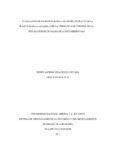Please use this identifier to cite or link to this item:
https://repository.unad.edu.co/handle/10596/14602Full metadata record
| DC Field | Value | Language |
|---|---|---|
| dc.contributor.advisor | Díaz Rodríguez, Genidth | - |
| dc.coverage.spatial | cead_-_acacias | spa |
| dc.creator | Pirateque Guevara, Edwin Alfredo | - |
| dc.creator | Roa Roa, Mercedes | - |
| dc.date.accessioned | 2018-01-31T22:47:03Z | - |
| dc.date.available | 2018-01-31T22:47:03Z | - |
| dc.date.created | 2017-10-25 | - |
| dc.identifier.uri | https://repository.unad.edu.co/handle/10596/14602 | - |
| dc.description.abstract | Esta investigación está basada en la evaluación de un producto comercial bilógico a base de la planta Melaleuca alternifolia aplicado para controlar la enfermedad Pestalotiopsis en palma de aceite variedad hibrido OxG, la cual, ha sido muy susceptible a Pestalotiopsis causando baja de taza fotosintética en las hojas debido al daño que causa el hongo. El chinche de encaje (Leptopharsa gibbicarina), es el vector de la enfermedad ya que indirectamente permite la entrada del hongo de la Pestalotiopsis a los foliolos cuando se alimenta de la sabia de los mismos, para el control de esta enfermedad se han utilizado algunas estrategias tanto mecánicas como la poda y métodos químicos como la utilización de fungicidas e insecticidas por absorción radicular pero no ha sido posible su control debido a su alto sobre costo en dosis y manejo. Para llevar a cabo la investigación con el producto biológico se seleccionaron 96 palmas de material hibrido ubicadas en la plantación de Palmas de Casanare de Villanueva Casanare, el objetivo era encontrar palmas afectadas, se diseñaron 4 tratamientos, en los cuales los 2 primeros son el producto biofungicida con diferentes dosis, el tercero un producto químico y finalmente el cuarto tratamiento testigo, en un diseño aleatorio con 4 repeticiones, 24 palmas por repetición, el objetivo fue realizar 4 aplicaciones ( cada 15 días ) y 6 evaluaciones ( 4 cada 15 días y 2 cada mes ) de manera cuantitativa y cualitativa del comportamiento del hongo en el área foliar tomando los debidos registros de longitud y fotográficos, con los datos obtenidos se realizó el análisis estadístico para concluir si el producto puede controlar la enfermedad y además si puede causar residualidad en hojas número 1 las cuales se encontraban sanas al momento de la primera aplicación. | spa |
| dc.format | spa | |
| dc.format.mimetype | application/pdf | spa |
| dc.language.iso | spa | spa |
| dc.publisher | Universidad Nacional Abierta y a Distancia UNAD | spa |
| dc.title | Evaluación de un biofungicida a base del extracto de la planta Melaleuca alternifolia como alternativa de control de la Pestalotiopsis en Palma de Aceite Hibrido OXG. | spa |
| dc.type | Proyecto de investigación | spa |
| dc.subject.keywords | Biofungicida | spa |
| dc.subject.keywords | Palma de Aceite | spa |
| dc.subject.keywords | Planta Melaleuca Alternifolia | spa |
| dc.description.abstractenglish | This investigation is based on the evaluation of a biologic commercial product based on the Melaleuca alternifolia plant. It has been put on to control the Pestaliosis disease that affects the oil palm. The hybrid palm has been very susceptible to the Pestaloptiosis. This disease causes photosynthetic low rate in the leaves because the damage caused by the Pestaloptiosis fungus. Leptopharsa gibbicarina is the vector insect of the disease, because when the bug lace is feeding on the sap in the leaflets, then the fungus gets in through the injury caused by the insect when it finishes eating. Some strategies have been used to control the disease, such as pruning (mechanical management), chemical methods by using fungicides and insecticides, also by root absorption, but it has not been possible its control due to the high costs as to dose and management. To bring about the investigation with the biological product. Ninety six palms of hybrid material were selected. These palms are located in the palm plantation Palmas del Casanare. This palm plantation is located in the municipality Villanueva (Casanare). The mean objective was to find affected palms with Pestaloptiosis disease. Four kinds of treatments were designed Two treatments consisted of using biofungicides in different dose. Another treatment consisted of using a chemical product, And a witness treatment. A random design with four repetitions. The objective was to carry out four applications (Every fifteen days) and six evaluations (four every fifteen days and two monthly) in a quantitative and qualitative manner of the fungus behavior in the leaf area. Photographic and lengh registry were taken. A statistical analysis with the obtained data is wanted to do. It is with the objective of concluding if the product controls the disease and moreover It is important to see if the product leaves residues on the leaf number 1. These leaves were healthy before the first application. | spa |
| dc.subject.category | Agronomía | spa |
| dc.rights.accesRights | info:eu-repo/semantics/openAccess | spa |
| dc.rights.acceso | Abierto (Texto Completo) | spa |
| Appears in Collections: | Agronomía | |
Files in This Item:
| File | Description | Size | Format | |
|---|---|---|---|---|
| 1118197187.pdf | Evaluación de un biofungicida a base del extracto de la planta melaleuca alternifolia como alternativa de control de la pestalotiopsis en palma de aceite hibrido oxg | 2.32 MB | Adobe PDF |  View/Open |
Items in DSpace are protected by copyright, with all rights reserved, unless otherwise indicated.
